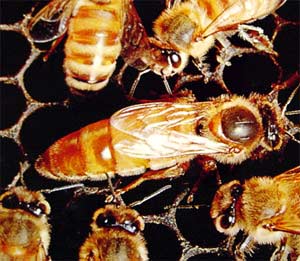My goal in this beekeeping adventure is to end up with a bunch of bees that can survive in today’s environment. In the last post, I touched the basis of my current goals and one aspect of them, Drones. Today, I wanted to touch on another aspect to this plan, the Queens.
There are many folks that recommend re-queening every Fall. The basis for this approach is that you are tackling two problems with one action.

The first problem is genetics control/swarming. By putting a new queen into the hive in the Fall, the pheromones will be strong (from the young queen) and the hive is much less likely to consider replacing her this Fall or swarm next Spring. Bees typically look to replace aging queens when the pheromones become weaker. If they do it on their own accord, they will end up with a gene pool that is beyond your control. But, as per my last post, my goal is to populate the region with my drones. So, it is not a problem with me if they raise their own queens. But what about the second issue? The swarming issue is more complicated (as I will go into later, I am not so sure that it is beneficial to the bees to continually combat the swarm behavior, unless you are taking steps of simulate a swarm situation (like with a split)).
The second reason to requeen is for varroa control. By replacing an established queen with a virgin queen, the hive goes into an ‘egg-laying dearth’ as the new queen becomes accustomed to the new hive and goes out to mate. This might be a week or three weeks. During this time, the breeding cycle of the varroa mite is interrupted. It can set them back substantially, thus giving a hive a leg up on the cycle. I do believe that this is a valid strategy, as the bees in the wild swarm to create this same kind of scenario (when the old queen leaves, the hive waits for the new queen to hatch and goes into a dearth of its own.) So, if you are preventing your bees from swarming and raising their own queens, requeening is a way to replicate what nature would do on its own. But, this only works if you let them go through a dearth.
If you pinch the old queen and, 1 day later, give them a young, recently mated queen, you are not creating a ‘dearth of brood.’ The new queen gets started laying immediately (and probably stronger), allowing the varroa to continue their cycle. When I requeen in the Fall (actually, in early to mid-July), in the Richmond, Virginia area, I do so by simply killing the old queen. The bees are forced to raise their own queen and necessarily go into a healthy dearth. Ideally, my new queen is mated and laying on September 1, when the bees will be starting to groom the new brood for Winter survival.
Although I do plan to raise queens, it is not my current intent to requeen (definitely not every year.) Instead, I hope to do natural splits to replicate the swarming mechanics of nature. As to my queens, I initially plan to use them to start new Nuc’s and as emergency replacements for queen losses at my established hives. We’ll see how that works out…
